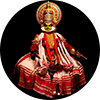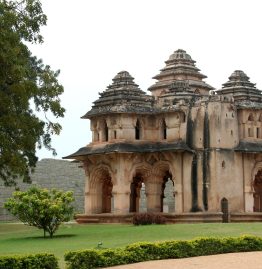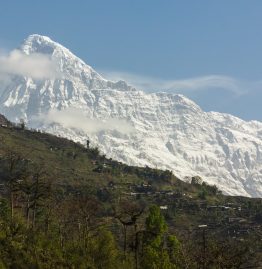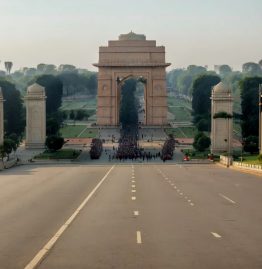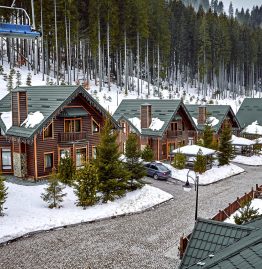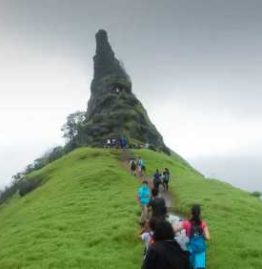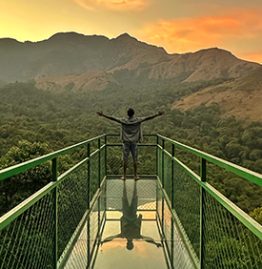Hampi is not just another tourist spot—it’s a living museum of India’s glorious past. Recognized as a UNESCO World Heritage Site, Hampi is a captivating town in Karnataka that once flourished as the capital of the Vijayanagara Empire. Imagine walking through vast ruins where every stone has a story to tell, where grand temples still echo with chants, and where nature and history blend into a surreal landscape of giant boulders, lush banana plantations, and the Tungabhadra River.
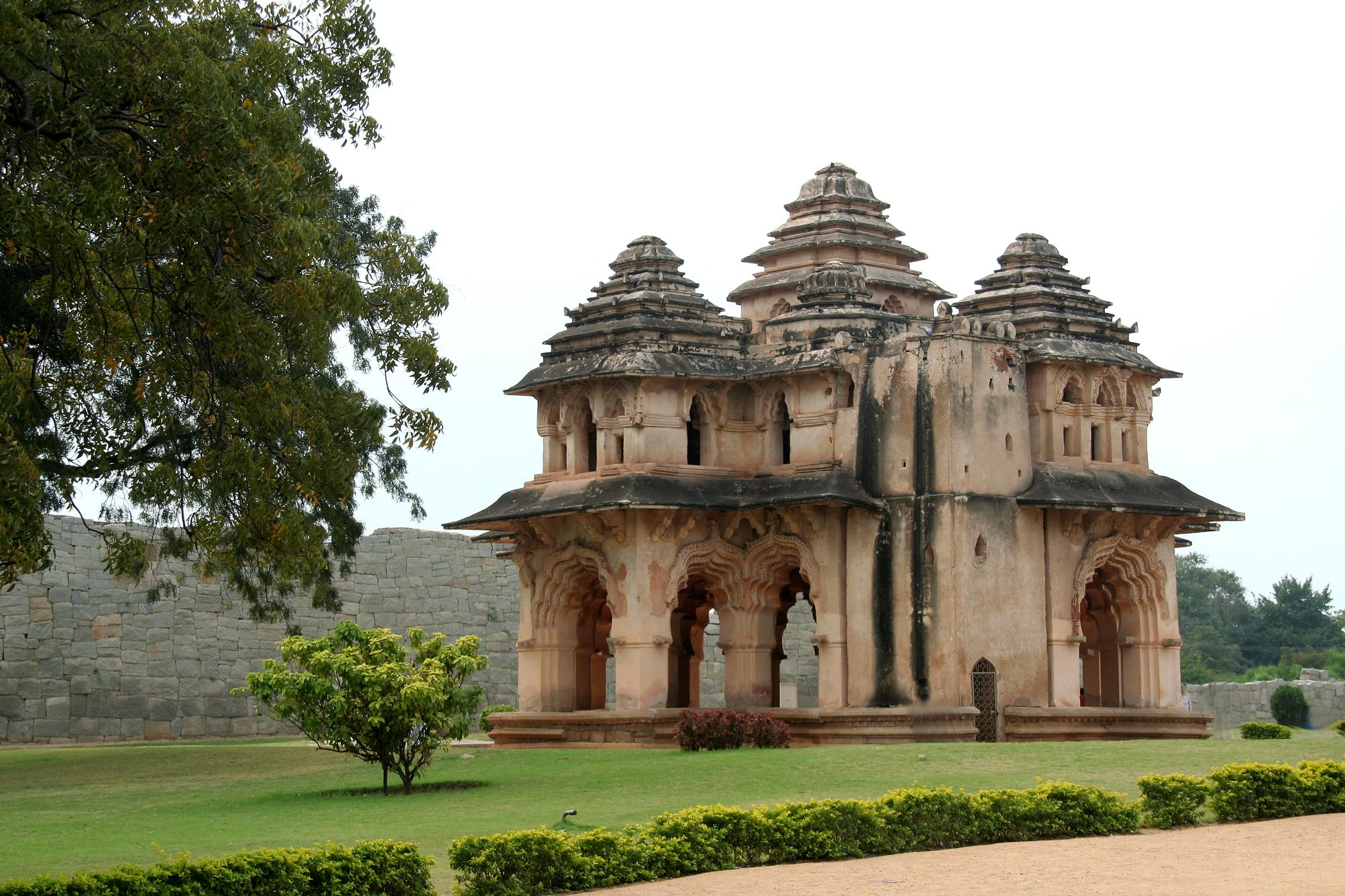
This guide takes you through Hampi’s history, temples, ruins, cultural significance, travel tips, and experiences to help you plan a memorable journey.
The Fascinating History of Hampi
Hampi’s story is a mix of mythology, grandeur, and tragedy.
Mythological Roots: The Land of Kishkindha
- Hampi finds its mention in the Ramayana as Kishkindha, the monkey kingdom ruled by Sugriva.
- It is believed that Lord Rama met Hanuman here while searching for Sita. Several places in Hampi, like Anjanadri Hill, are linked to Hanuman’s birthplace.
Vijayanagara Empire (1336–1565): The Golden Age
- Founded by Harihara and Bukka, the Vijayanagara Empire grew into one of the wealthiest kingdoms in the world.
- Hampi became its capital, known for prosperity, trade, and art. Merchants from Persia, Portugal, and China came to trade horses, spices, and gems.
- Foreign travelers like Domingo Paes and Abdul Razzaq described Hampi as “larger than Rome” and “the world’s richest city.”
The Downfall
- In 1565, the empire was defeated in the Battle of Talikota by the Deccan Sultanates.
- The city was looted, temples were destroyed, and Hampi never regained its former glory.
- Today, its ruins are a haunting reminder of both prosperity and devastation.
The Temples of Hampi
Hampi is often called a “temple town” because of its hundreds of religious monuments. Each temple is unique, reflecting Dravidian architecture, fine carvings, and mythological tales.
1. Virupaksha Temple – The Living Temple
- Dedicated to Lord Shiva (Virupaksha form).
- Oldest functioning temple in India, dating back to the 7th century.
- The main gopuram (entrance tower) is 50 meters tall, dominating Hampi’s skyline.
- Inside, you’ll find intricately carved halls and a pin-hole camera effect where the gopuram’s inverted shadow appears on a wall.
- Daily rituals and annual festivals like Hampi Utsav make it a spiritual hub.
2. Vittala Temple – The Symbol of Hampi
- Known for its world-famous stone chariot, featured on India’s ₹50 currency note.
- The musical pillars produce notes when tapped, though tapping is now restricted for preservation.
- The temple was built in the 15th century and showcases Vijayanagara’s artistic excellence.
- Don’t miss the Ranga Mantapa, a hall with 56 musical pillars.
3. Hazara Rama Temple – A Story in Stone
- Dedicated to Lord Rama.
- Its walls are decorated with over a thousand carvings depicting the Ramayana.
- Used as a private temple for royalty, it reflects both devotion and power.
4. Achyutaraya Temple – A Forgotten Marvel
- Built in 1534 and dedicated to Lord Tiruvengalanatha (a form of Vishnu).
- Located between Gandhamadana and Matanga Hills.
- Surrounded by Achyutaraya Bazaar, showing how temples were central to trade and social life.
5. Hemakuta Hill Temples – The Hill of Gold
- A cluster of small shrines with simple yet elegant architecture.
- According to legend, Lord Shiva did penance here before marrying Goddess Pampa.
- The hill is a favorite spot for sunrise and sunset views.
6. Other Notable Temples
- Krishna Temple – Built by Krishnadevaraya to celebrate his victory over Odisha.
- Malyavanta Raghunatha Temple – Associated with Lord Rama’s stay before the war with Ravana.
- Anjanadri Hill Temple – Believed to be Hanuman’s birthplace.
The Royal Ruins of Hampi
Apart from temples, Hampi’s ruins showcase the royal lifestyle and architectural brilliance of the Vijayanagara kings.
1. Royal Enclosure
- Spread over 59,000 sq. meters, it was the seat of power.
- Key attractions:
- Mahanavami Dibba – A grand platform for festivals and military parades.
- Stepped Tank – A geometric water tank with stunning symmetry.
- King’s Audience Hall – Where rulers addressed their people.
2. Lotus Mahal
- Shaped like a lotus, this two-storey structure combines Hindu and Islamic styles.
- Used as a socializing palace for queens. Its symmetrical arches and lotus-petal design make it unique.
3. Elephant Stables
- A row of 11 domed chambers used to house royal elephants.
- Built in Indo-Islamic style, it reflects the empire’s grandeur.
4. Queen’s Bath
- A massive bath surrounded by balconies and decorated with ornate carvings.
- The 6-foot-deep pool was used by royal women.
5. Watch Towers & Gates
- The city had massive gates, fortifications, and watchtowers to safeguard its wealth.
The Natural Beauty of Hampi
Hampi is not just ruins—it’s also nature at its best.
- Matanga Hill: Best place for sunrise views.
- Sanapur Lake: A serene spot with coracle rides.
- Tungabhadra River: Offers coracle rides and beautiful landscapes.
- Anegundi Village: A rustic town across the river, older than Hampi itself.
Culture & Festivals of Hampi
- Hampi Utsav (November): A 3-day cultural festival with music, dance, and light shows.
- Pampa Festival: Celebrated at Virupaksha Temple, honoring Goddess Pampa.
- Local Handicrafts: Stone carvings, banana fiber crafts, and Lambani embroidery.
Food & Stay in Hampi
- Local Cuisine: Try traditional Karnataka dishes like ragi mudde, jolada rotti, and spicy curries.
- Traveler Cafes: Mango Tree, Laughing Buddha Café, and Gopi Guesthouse are popular.
- Stay Options: Budget guesthouses, heritage stays, and luxury resorts near Hospet.
Best Time to Visit Hampi
- October – February: Pleasant and ideal for sightseeing.
- March – May: Hot but less crowded.
- June – September: Green and refreshing, though some treks may be tricky.
Travel Tips for Hampi
- Plan 3–4 days for a relaxed exploration.
- Bicycles and scooters are the best way to explore ruins.
- Hire a local guide to uncover hidden stories.
- Carry water, hats, and sunscreen—the sun can be harsh.
- Respect temple customs—dress modestly and remove shoes.
- Don’t miss sunrise at Matanga Hill and sunset at Hemakuta Hill.
Frequently Asked Questions (FAQs)
Q1. What is Hampi famous for?
Hampi is famous for being the capital of the Vijayanagara Empire, its stunning temples like Virupaksha and Vittala, the stone chariot, royal enclosures, and its unique boulder-filled landscape. It is also a UNESCO World Heritage Site.
Q2. How many temples are in Hampi?
There are more than 80 major temples and hundreds of smaller shrines. The Virupaksha Temple, Vittala Temple, and Hazara Rama Temple are the most significant.
Q3. How many days are enough for Hampi?
At least 3 days are recommended. Day 1 for temples, Day 2 for royal ruins, and Day 3 for hills, river, and Anegundi. Longer stays allow deeper exploration.
Q4. Is Hampi good for solo travelers?
Yes, Hampi is safe for solo travelers, including women. Many backpackers visit. Stay in guesthouses or hostels in Hampi Bazaar for a social vibe.
Q5. What is the best way to reach Hampi?
- By Train: Hospet (13 km) is the nearest railway station.
- By Air: Hubli (143 km) and Bengaluru (350 km) are the nearest airports.
- By Road: Well connected with buses from Hospet, Bengaluru, and Hyderabad.
Q6. What should I buy from Hampi?
Stone carvings, banana fiber products, Lambani embroidery, and local handicrafts make unique souvenirs.
Final Thoughts
Hampi is more than a destination—it’s an experience of India’s golden past. Walking through its ruins, temples, and bazaars, you can almost hear the echoes of an empire that once rivaled the world’s greatest cities.
Whether you’re a history enthusiast, an adventure traveler, or someone seeking peace, Hampi will leave you enchanted. From the divine Virupaksha Temple to the mysterious Royal Enclosure, from sunrise treks to cultural festivals, Hampi offers a journey you’ll cherish forever.
So, pack your bags, step into the past, and explore Hampi—the city of history, temples, and ruins.












